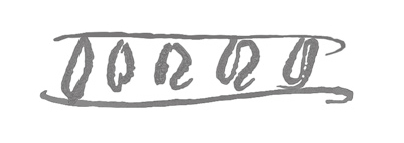From J. E. Gray [1846–54]1
Bivalve have normally a series of 2 or 3 diverging teeth under the umbo and laminal lateral teeth2
The lateral teeth are sometime in arcadæ Nuculidæ divided across into numerous lobes looking like a series of transverse teeth interlocking into each other3

CD note:
I looked at series of Arcadæ, & a good series from teeth at umbo with ligament to mere row of crenations—4
But this case not good to quote.
Footnotes
Bibliography
Correspondence: The correspondence of Charles Darwin. Edited by Frederick Burkhardt et al. 29 vols to date. Cambridge: Cambridge University Press. 1985–.
Fossil Cirripedia (1851): A monograph on the fossil Lepadidæ, or, pedunculated cirripedes of Great Britain. By Charles Darwin. London: Palaeontographical Society. 1851.
Fossil Cirripedia (1854): A monograph of the fossil Balanidæ and Verrucidæ of Great Britain. By Charles Darwin. London: Palaeontographical Society. 1854.
Living Cirripedia (1851): A monograph of the sub-class Cirripedia, with figures of all the species. The Lepadidæ; or, pedunculated cirripedes. By Charles Darwin. London: Ray Society. 1851.
Living Cirripedia (1854): A monograph of the sub-class Cirripedia, with figures of all the species. The Balanidæ (or sessile cirripedes); the Verrucidæ, etc. By Charles Darwin. London: Ray Society. 1854.
Summary
Lateral teeth in Arcadae.
Letter details
- Letter no.
- DCP-LETT-13814
- From
- John Edward Gray
- To
- Charles Robert Darwin
- Sent from
- unstated
- Source of text
- DAR 205.5: 216 (Letters)
- Physical description
- AL inc, CD note
Please cite as
Darwin Correspondence Project, “Letter no. 13814,” accessed on 18 April 2024, https://www.darwinproject.ac.uk/letter/?docId=letters/DCP-LETT-13814.xml


